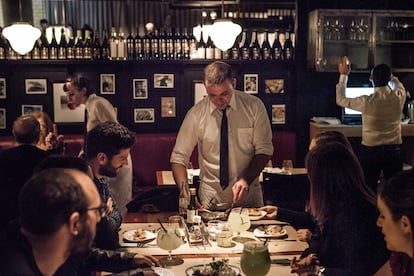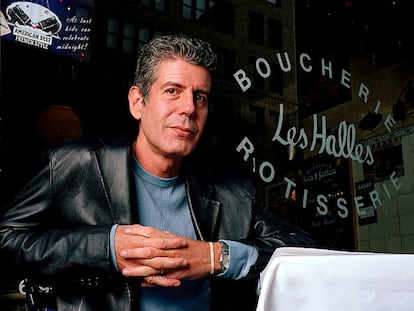Gastrotourism in Buenos Aires: Between pastrami, baklavas and pretzels
Beyond pizzas and ice creams, the Argentine capital enjoys a rich gastronomic and cultural tradition from Armenia, Lebanon and the countries of Eastern Europe

Buenos Aires rightly boasts of the quality of its pizzas and ice cream, the recipes for which immigrants from Italy brought over a century ago. But the Argentine capital should also brag about its rich culinary and cultural traditions from Armenia and Eastern Europe, from which the Jews who settled in the country at the end of the 19th century and beginning of the 20th century fled. To get to know these cuisines better, here are some palate-pleasing tips for dining in the Argentine capital.
Jewish immigration in Argentina is evident in the Germanic and Slavic last names of a significant percentage of the country’s inhabitants. Yiddish, the language of Ashkenazi Jews, was spoken, heard and read in Buenos Aires until only a few decades ago: newspapers like Di idishe Zaiting were published and there was an active theater program in that language as well. Although the language is hardly spoken today, the grandchildren and great-grandchildren of people who came from Eastern Europe continue to pay tribute to their ancestors’ culture through restaurants such as Mishiguene, which means “crazy” in Yiddish. That’s the name chef Tomás Kalika gave his restaurant, which he and his partner, Javier Ickowicz, proudly call “immigrant cuisine.” Through his menu, he travels through Eastern Europe with ingredients and recipes like vareniki (potato dumplings) and gefilte fish (stuffed fish). The restaurant also includes Sephardic cuisine, as represented in the Jewish-style artichokes and bourekas, savory stuffed puff pastries.
The restaurant, located next to the charming Japanese Garden in the Palermo neighborhood, offers haute cuisine — last year it was ranked 15th on The World’s 50 Best list of restaurants in Latin America — so for those looking for something more informal, the owners opened Café Mishiguene. The café closes just when its sister restaurant opens, at 7 p.m.; it serves bagels with smoked trout, different types of hummus and scrambled eggs from breakfast time onward.
One of the delicacies of Ashkenazi Jewish cuisine is pastrami. In Buenos Aires they are so fond of this cured beef that in the restaurant Hola, Jacoba, in Palermo, they proudly serve it in overstuffed sandwiches that are hard to fit in one’s mouth, and in several different forms like shawarma or pita. But it always comes with sour pickles, which will make many people feel like they are in a New York Jewish deli, just a little further south geographically.
Jewish cuisine offerings are also abundant in the adjacent neighborhood of Villa Crespo. This area is full of Jewish restaurants such as La Crespo, which has won over porteños (residents of Buenos Aires) with its intensely red borscht soup (from beets, the dish’s main ingredient), and its hearty meat stews like goulash and yarkoie (a cut of beef) with roasted potatoes, all of which came over from Eastern Europe. And when you urgently need something sugary, Moisha bakery delivers with cinnamon-sugar pretzels and apple strudel that looks as if it has just arrived from Vienna. The bakery also has branches in the Recoleta, Núñez, Caballito and Villa Urquiza neighborhoods.
At some point you must experience the bustling atmosphere of a long-standing bakery like Helueni, at 2495 Córdoba Avenue, near the Once neighborhood, where many Jewish stores are located. The bakery’s owners, who are descendants of Jewish-Syrian immigrants, cater to an endless stream of customers who flock to the place for Sephardic puff pastry delicacies like vegetable or egg boios. The lajmayin, a sort of open pie that resembles a mini pizza, and the syrupy baklava, which is baked on the spot, are other specialties that have made this busy bakery famous.
Welcome to new Armenia
If you have Armenian ancestors, your last name is probably very long and ends with the suffix “-ian.” In the 1940s, about 18,000 Armenians lived in Buenos Aires, and the community became so large that it published its own newspaper, the Avedaper, founded in 1964. Today, the epicenter of this community is located in the neighborhood of Palermo on a street that was renamed Armenia and the surrounding Honduras, El Salvador and Scalabrini Ortiz Streets. They all have places of interest for the Armenian community, as well as for those who want to try the culinary delights of this area informally known as “Little Armenia.”
To begin, one could visit El Viejo Agump, a family-run establishment located inside a typical porteño mansion, or instead try the menu at the Armenia restaurant, on the second floor of the Armenian Cultural Association, a huge hall that serves dishes like karni yarik (baked eggplants stuffed with meat) or michugov (morsels of meat with wheat and spices).
And judging by the long lines, a visit to Sarkis, a restaurant located on the corner of Thames and Jufré Streets in the neighborhood of Villa Crespo, seems obligatory. Inside the white-and-red house where it is located, the joyful bustle of porteño families in celebration mode — a common occurrence in this indefatigable city — awaits, as does a feast of dishes with Armenian flavors like stuffed grape leaves, lamb kafta and rice pilaf. All of it will make it very difficult for us to follow that diet we’d started.
Practical Guide
- Mishiguene: Lafinur, 3368.
- Café Mishiguene: Hair, 3181.
- Hello, Jacoba: Thames, 1801.
- La Crespo: Vera, 1001.
- Moisha Bakery: they have five locations throughout Buenos Aires.
- Helueni: Avenida de Córdoba, 2495.
- Old Agump: Armenia, 1382.
- Armenia Restaurant: Armenia 1366, 1st floor.
- Sarkis: Thames, 1101.
Sign up for our weekly newsletter to get more English-language news coverage from EL PAÍS USA Edition
Tu suscripción se está usando en otro dispositivo
¿Quieres añadir otro usuario a tu suscripción?
Si continúas leyendo en este dispositivo, no se podrá leer en el otro.
FlechaTu suscripción se está usando en otro dispositivo y solo puedes acceder a EL PAÍS desde un dispositivo a la vez.
Si quieres compartir tu cuenta, cambia tu suscripción a la modalidad Premium, así podrás añadir otro usuario. Cada uno accederá con su propia cuenta de email, lo que os permitirá personalizar vuestra experiencia en EL PAÍS.
¿Tienes una suscripción de empresa? Accede aquí para contratar más cuentas.
En el caso de no saber quién está usando tu cuenta, te recomendamos cambiar tu contraseña aquí.
Si decides continuar compartiendo tu cuenta, este mensaje se mostrará en tu dispositivo y en el de la otra persona que está usando tu cuenta de forma indefinida, afectando a tu experiencia de lectura. Puedes consultar aquí los términos y condiciones de la suscripción digital.
More information
Archived In
Últimas noticias
Maduro pleads not guilty before the federal court in New York: ‘I am still the president of Venezuela’
A new test can detect Alzheimer’s from a finger prick
UN team enters Sudanese city of El Fasher after paramilitary massacre: ‘It’s like a ghost town’
A recipe for resistance: Indigenous peoples politicize their struggles from the kitchen
Most viewed
- Gilles Lipovetsky: ‘If you want to live better and fall in love, take Prozac, don’t look to philosophy’
- Alain Aspect, Nobel laureate in physics: ‘Einstein was so smart that he would have had to recognize quantum entanglement’
- Alvin Hellerstein, a 92-year-old judge appointed by Bill Clinton, to preside over Maduro’s trial in New York
- Why oil has been at the center of Venezuela-US conflicts for decades
- Maduro’s downfall puts China’s relationship with Venezuela to the test










































